Mindful Eating for Sustainable Weight Loss
Introduction to Mindful Eating
Hey there, it’s Bob! If yer reading this, then I’m guessing you’re interested in learning about mindful eating. Well, let me be the first to say that yer in for a treat. Mindful eating is an amazing way to make sure you’re gettin’ the most out of your food and can even help you lose weight without tryin’ too hard. So, keep on readin’ if you wanna know more.
First off, what exactly is mindful eatin’? Well, it’s all about payin’ attention to the food you’re eatin’. It means being aware of how and why you’re eatin’ and not just shovin’ whatever into your mouth on autopilot. The goal here is to savor every bite by noticin’ the flavors, colors and textures of the food so that you can appreciate it more and actually enjoy it.
Now, mindful eatin’ has some pretty awesome benefits. For starters, it gives you a better connection with your food which can help you recognize your personal hunger and fullness signals. This means knowing when you’re truly hungry and when to stop when you’re full. Mindful eatin’ also helps you recognize emotional eatin’, so you don’t end up munchin’ mindlessly for any other reason than actual hunger.
Step One: Identify Your Reasons for Wanting to Lose Weight
If you’re wanting to take control of your weight and health, the first step is to identify what it is that has motivated you to make this change. Whether it’s looking better in a swimsuit, running a 5K, or reducing your cholesterol levels, having clarity on why you’re making a lifestyle change makes it easier to stay motivated.
Ask yourself “Why do I want to lose weight?” and be honest with your answer. Maybe it’s knowing you’ll fit into those skinny jeans again; or becoming more active with your family; or improving your overall lifestyle. Whatever the reason, this is the start of your journey – so be sure to hold onto it!

Once you’ve identified your motivation for wanting to lose weight, determine the level of importance – is this something you really need to do now, or can you wait a few months? If this is something you’d like to tackle sooner, than later, then set yourself up for success. Start by writing down your goals and desired outcomes, along with specific steps you can take to reach them.
Step Two: Become Aware of Your Hunger and Fullness Signals
A crucial part of Mindful Eating is becoming attuned to your body’s hunger and fullness signals. A lot of us tend to ignore these indicators, eating well beyond the point of satisfaction. This can lead to overeating and weight gain over time. So, it’s a wise idea to become familiar with how hungry or full you are before and after each meal.
In order to do this effectively, you need to practice self-awareness. For instance, ask yourself if you’re truly hungry or if something else is driving you to eat. That could be boredom, stress, peer pressure, or even habit. If it’s not physical hunger, then try to find ways to satisfy your emotional needs without food.
If you’re experiencing true hunger, wait a few minutes and then rate your hunger on a scale of 1 to 10 (with 1 being famished and 10 being bursting). It can be helpful to carry snacks so that you don’t get too ravenous and overeat. Whenever you do eat, pay attention to your body’s responses throughout the entire process. Eventually, you’ll start recognizing when you’re getting full and stop before you stuff yourself. In addition, when you have those moments when you feel like you just can’t eat anymore, make a mental note of that feeling. That’s your body telling you it’s satisfied and no more food is needed!
Step Three: Slow Down and Enjoy Your Food
We all know it’s easy to just wolf down our food, but if you really want to get the most out of mindful eating, it’s important to slow down and savor your meal. Eating slowly gives your brain time to register when you’re full, and it also has a few other perks. When you slow down, you get to appreciate all the flavors that went into making that delicious food. Plus, it can be a great way to relax and clear your mind of all the stress of your day.
It might seem like slowing down and savoring your food will take forever, but once you get the hang of it, it becomes second nature. Start by counting how many chews you take before each swallow. This can help you become aware of the texture of your food and the tastes it brings with it. Don’t rush through your meal, take your time and get the most out of every bite. Once you start doing this regularly, you’ll be surprised at how quickly your meals pass.
If you find yourself struggling to slow down, try turning off all screens or putting your phone in another room. Not only does this give your full attention to your meal, but it also prevents any distractions from taking away from the experience. Or, if you’re having dinner with friends or family, why not turn it into an enjoyable conversation? Everyone loves a good chat while they eat.
So next time you sit down to enjoy a meal, remember that mindful eating isn’t just about losing weight – it’s about truly connecting with your food and getting all the pleasure you can out of it. So take it slow, hit pause, and let your taste buds do the talking!
Step Four: Slow Down and Enjoy Your Food
Eating too quickly is a recipe for disaster, because when you eat fast, it’s hard to really enjoy the tastes. So take your time! Put your fork down between bites, chew your food slowly, savor the flavor of each bite, and really think about what it tastes like. When you slow down and savor your food, it becomes easier to listen to your body and recognize when you’re full. And who knows? You might even find that those few extra moments are just what you needed to truly savor the flavors, both of which can lead to a more enjoyable eating experience.
Step Five: Reflect On Your Eating Habits
It’s time to take a step back and gain some perspective on your eating habits. What could you be doing differently? Are there any routines that you’re leaving out? It may be helpful to keep a food journal or use a calorie tracking app to get an idea of what you’re actually consuming. Taking the time to look steadily at your habits can be a great way to identify patterns and figure out how you can make better choices.
To really analyze what you’re doing, ask yourself some tough questions. Do you eat when you’re bored? Tired? Stressed? And when you do, is it beneficial or detrimental? Are there unhealthy habits that have lingered in your life that need addressing? Being mindful of these things can bring more meaningful, lasting change than quick fixes.
It’s also important to try and assess your progress. Are you seeing positive outcomes from your mindful eating practices? Tracking the different changes you make and the results they lead to can be a great motivator and help you stay focused.
So take some time and reflect on your eating habits. Doing so can offer invaluable insight, allowing you to make healthier choices that fit into your unique lifestyle.
Conclusion
Mindful eating is a great way to lose weight, become more aware of your own body and increase your overall mental health. It goes beyond just dieting: mindful eating shifts our focus away from weight loss and puts it into the pleasure of actually enjoying meals. While this process may take some time, the long-term benefits make it worth it. Following the five steps outlined above will help you start your journey toward becoming a mindful eater.
It ain’t gonna be easy! I remember when I first started out, I was like a deer in headlights trying to wrap my head around all that mindful eating stuff. But with practice and commitment, I eventually got the hang of it. Heck, now I can chow down while being totally in tune with how my body feels.
If you’re ready to take the plunge, think of mindful eating as an adventure—you won’t regret it. And never forget that you have the power to make healthier choices for yourself. That’s what this is really about.
So get out there, be mindful about what you put into your body, and nourish it in a way that works for you. You’re worth it.
Healthy Eating FAQs
How is mindful eating different from dieting?
Mindful eating is all about being present and aware of your body’s hunger signals and the foods that you’re eating. It’s not about calorie counting or restrictive diets. Instead of restricting yourself to a certain amount of food and calorie counting, mindful eating allows you to listen to your body’s hunger signals, eat when you’re hungry and stop when you’re full. You’re also paying attention to the sensations of hunger and fullness that your body gives you.One of the big differences between mindful eating and dieting is the long-term goal. With dieting, the goal is to lose weight quickly, while mindful eating is focused on cultivating long-term habits and creating a healthy relationship with food. Mindful eating encourages you to become aware of your eating habits, notice how food makes you feel, and to develop a healthy relationship with food.Another key distinction between mindful eating and dieting is the emphasis on nutrition. With dieting, you’re focused on counting calories and restricting certain foods. With mindful eating, it’s about making mindful food choices and focusing on whole, natural foods. Eating healthy, nourishing foods can have a positive impact on your health, both physically and mentally.Finally, mindful eating encourages you to listen to your body and to be aware of how you feel after eating. Dieting can often cause a lot of guilt and shame, whereas mindful eating encourages you to be gentle with yourself. Mindful eating also helps to foster awareness of your emotions and how they impact your eating decisions.Overall, mindful eating is much different than dieting in that it focuses on creating long-term habits, nutrition, and how you feel after eating. Dieting is often focused on quick weight loss and restricts certain foods, while mindful eating encourages mindful food choices and tuning into your body’s hunger signals.
How do I start mindful eating?
I know it sounds like a tricky concept, but mindful eating for weight loss can be super simple once you get the hang of it! There’s no one-size-fits-all formula for mindful eating, so the best place to start is by being aware of what and how much you’re eating. That means slowing down and savoring each bite and pay attention to the flavor, texture, and smell of the food.
Additionally, take time to consider your own hunger and fullness cues, and honor them. Don’t scarf down your food, but also don’t restrict yourself either. That means if you’re really hungry, don’t wait until it’s “mealtime” to eat. And if you’re feeling full, don’t feel guilty about not finishing your plate. You don’t have to finish if you’re not hungry for it.
Have fun with mindful eating, too! Try to make it a relaxing experience. Turn off the TV, put away your phone, and try to create a mindful space to eat. Don’t beat yourself up if your mind wanders; instead, focus on bringing your attention back to the food. That’s all part of the process.
If you’re still feeling uncertain, consider talking to your doctor or a nutritionist or dietitian. You can also access online resources to learn more about mindful eating and get tips on how to make it part of your weight loss plan. To make mindful eating a lasting habit, practice it as often as you can — it’ll soon become a normal part of your routine. Good luck!
What 3 foods to stop eating to lose weight?
Well,
as far as I’m concerned, if you want to lose weight, you should cut out sugary drinks and heavily processed foods. Sodas and energy drinks are loaded with sugar and calories, and they won’t do you any favors. Processed foods are too high in added fats and are often filled with artificial ingredients, so they’re best avoided.
If you’re serious about slimming down, you’ll also want to give up processed and fried snacks. Those salty chips and fatty fries may taste good, but they won’t help you get any closer to your weight loss goals. They’re filled with empty calories and don’t do anything to help you feel full.
And lastly, if you want to make a real difference, you’ll want to stay away from fast food. Burgers and fries may be tasty, but they’re also loaded with unhealthy fats, sugar and calories. Stick with whole, natural foods and you’ll be well on your way to achieving your goals.
mindful eating for weight loss
When it comes to weight loss, mindful eating can be a powerful tool. By paying close attention to what you eat, you can create a plan that fits your specific needs.
For starters, it’s important to be aware of your hunger and fullness levels. Knowing when you’re truly hungry and when you’re actually full can help you make better decisions about portion sizes. Since mindful eating is all about listening to your body, you should also pay attention to how foods makes you feel. For example, if a certain food makes you feel bloated or uncomfortable, it can be beneficial to avoid it.
In addition, mindful eating is a great way to become more aware of your food choices. Try to make smart decisions when it comes to what you eat. Additionally, it can be helpful to focus on the present moment. This means slowing down and enjoying each bite of food without multitasking or feeling rushed.
Finally, mindful eating can help you create healthy habits that can be maintained over the long term. You can start by making small changes. For instance, make a conscious effort to eat more fruits and vegetables or try to avoid snacking mindlessly in front of the TV.
In conclusion, mindful eating can be an effective strategy for weight loss. Between its ability to help you become aware of your hunger and fullness levels, its potential to help you make smart food choices, and its ability to help you create healthy habits, it can make it much easier to stick to your goals.






